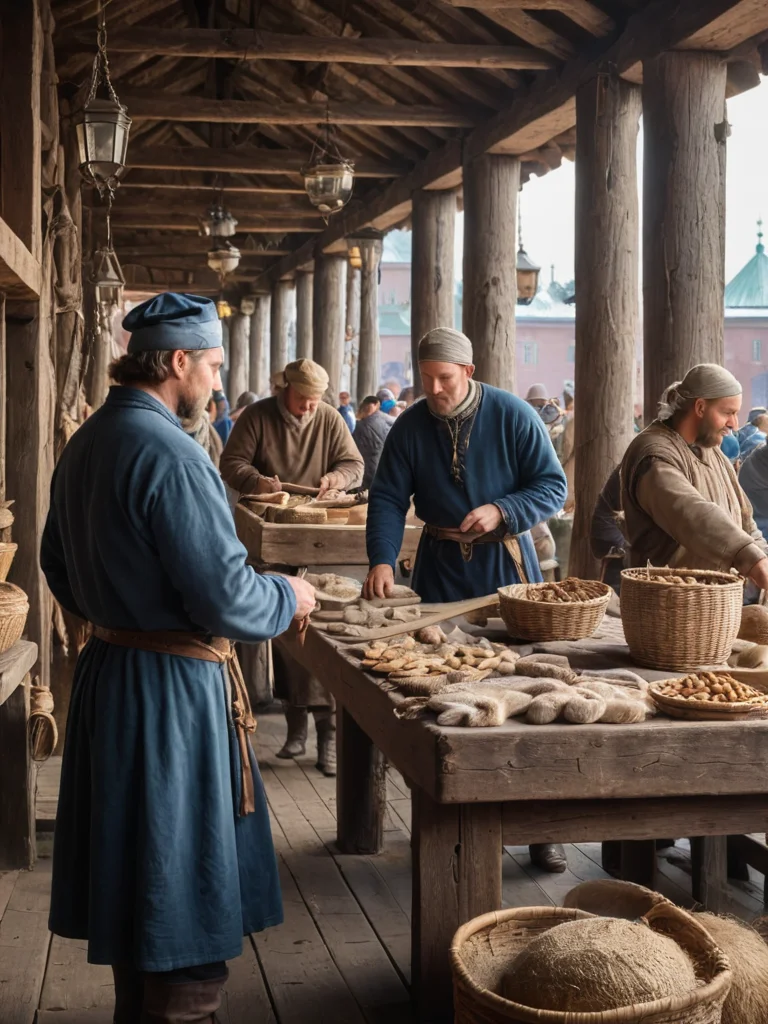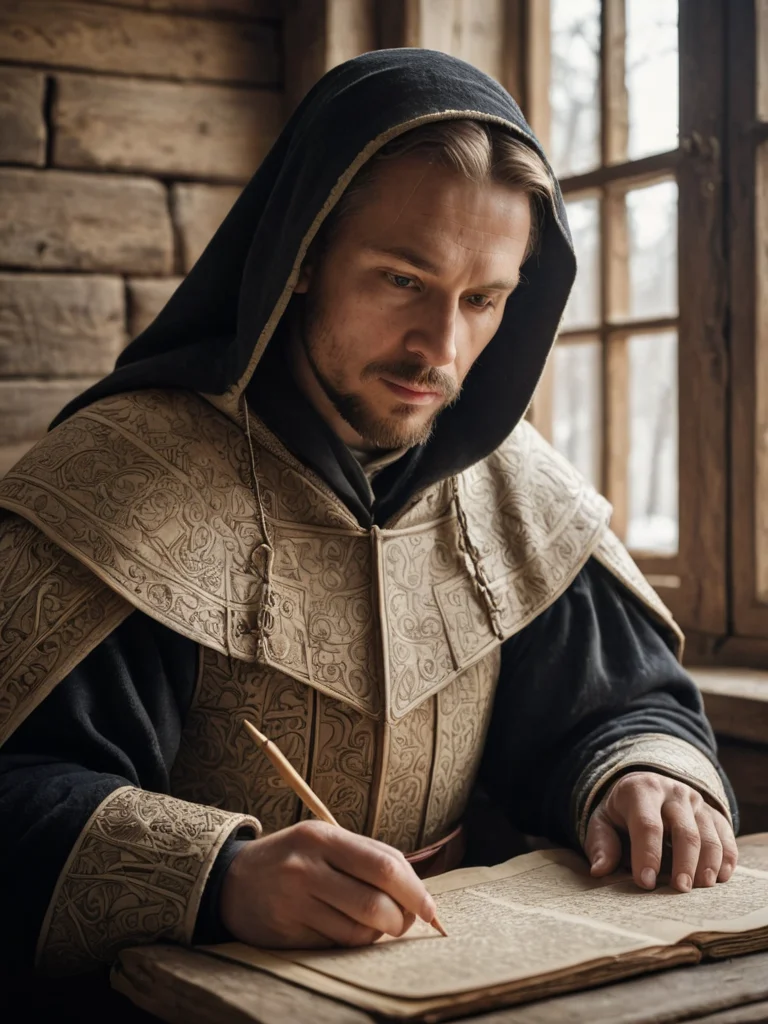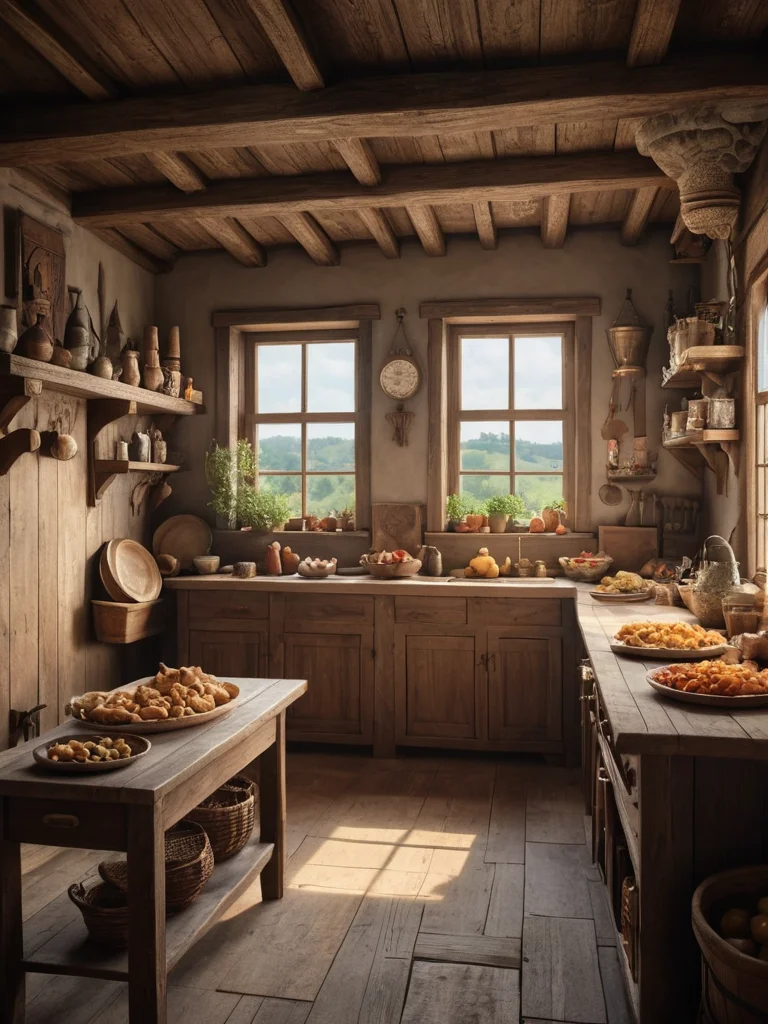Welcome to history-moments.ru, where we delve into the fascinating world of the past! Today, our journey takes us to one of the most unique and enigmatic corners of Ancient Rus’ – the free city of Veliky Novgorod. Imagine: the 11th-15th centuries, princes are fighting for power in Rus’, centralized states are forming, and in the northwest, on the banks of the Volkhov River and Lake Ilmen, something entirely different is flourishing – a powerful trading republic, where decisions were made not by a single prince, but at a popular assembly – the veche. It was a special world, unlike Kyiv, Vladimir, or Suzdal. The Novgorod land, like a magnet, attracted merchants from all over Europe, and its inhabitants built their lives, laws, and culture, independent of the usual feudal order. It is this unique character of Novgorod that makes the daily life of its inhabitants such a captivating topic of study. From how great trade deals were concluded to what simple artisans had for breakfast – every aspect of a Novgorod resident’s life was imbued with a spirit of freedom, entrepreneurship, and civic-mindedness.
We invite you on a journey through time to lift the veil on the everyday lives and celebrations of those who lived in this amazing city. You will learn how its economy worked, who made up its society, what Novgorod residents ate and wore, and how the famous veche influenced the life of every citizen. Prepare to be amazed, because the Novgorod Republic is not just a page in a history textbook, it is a living organism whose pulse is still felt in our hearts.
What Novgorod Relied On: From Trade to Craft Workshops
The foundation of Veliky Novgorod’s prosperity was, undoubtedly, trade. Historians believe that its strategic geographical location, connecting the Baltic and Volga trade routes, allowed Novgorod to become a key center of international commerce in Northeastern Europe. Enormous volumes of goods passed through it, from Scandinavia and the Baltics to Constantinople and the East. Merchants were the true elite of Novgorod society, possessing immense influence and wealth. Their caravans, laden with furs, wax, honey, timber, and flax, were sent to the cities of the Hanseatic League – Lübeck, Visby, Bruges, as well as to other Russian principalities and lands. Novgorod merchants not only sold goods but also brought luxury items, spices, fabrics, and metals to the city that were not found in Rus’. For example, Novgorod coins would not have been minted without German silver, and the attire of wealthy Novgorod residents would not have been complete without Flemish cloth.
Trade, in turn, stimulated the development of artisanal production. Novgorod was a city of craftsmen. Dozens of different crafts flourished here, each with its own guild organizations and traditions. Archaeological excavations constantly confirm the highest level of Novgorod’s artisans. Just imagine: woodworkers not only made wooden houses and the pavements that paved the city streets but also ships – longboats and ushkui, capable of withstanding long sea voyages. Blacksmiths forged tools, weapons, household utensils, and even created works of art from metal. Jewelers were renowned for their exquisite ornaments, using filigree, granulation, and cloisonné enamel, which indicated a connection with Byzantine and Eastern traditions.
In addition, leatherworking, shoemaking, pottery, weaving, and bone carving were actively developed in Novgorod. Each district of the city, or “konets,” could specialize in a particular type of craft. For example, it is known that the Nerevsky konets was dominated by artisans, while the Torgovaya Storona was home to merchants. This specialization allowed the city to produce a wide range of goods not only for domestic consumption but also for export, further strengthening its economic power. It is believed that every Novgorod household, even if it belonged to a merchant, had its own workshop or at least a small courtyard for economic activities. Thus, Novgorod was not just a transit point, but a true industrial and trading giant of its time.
We should not forget about agriculture either. The lands surrounding Novgorod, although not the most fertile, supplied the city with bread, vegetables, meat, and milk. Rural residents, or smerds, paid tribute to Novgorod and supplied food, ensuring the viability of the vast urban organism. Novgorod also controlled extensive territories from which valuable furs – ermine, sable, marten – were obtained, which were the main export commodity.
Who Lived in Novgorod: Social Classes, Families, and the Mysteries of Birch Bark Letters

The society of the Novgorod Republic had a rather complex social structure, but at the same time, it had an astonishing mobility for its time. Historians distinguish several main groups of the population, each playing its role in the life of the city. At the top of the social ladder were the boyars – hereditary nobles, major landowners, and influential political figures. They controlled important positions, such as posadnik and tysyatsky, and determined the internal and external policy of the republic. Their wealth was measured not only by land but also by vast reserves of furs, wax, and other goods.
The next most significant group were the merchants. As we have already mentioned, this was a powerful and influential stratum whose trade operations spanned half the world. Merchants were united in peculiar corporations or guilds, for example, the famous “Ivanovo sto” at the Church of John the Precursor on Opoki. Membership in such associations provided not only economic but also political advantages.
Next came the zhitye lyudi – these were prosperous townspeople, not necessarily merchants or boyars, but who owned real estate, workshops, were engaged in crafts or small trade. They formed the basis of urban self-government and actively participated in veche assemblies, although their voice might have been less weighty than that of the boyars.
The main mass of the urban population consisted of artisans (chernye lyudi, or commoners) and small traders. It was they who ensured the daily life of the city, producing everything necessary, from shoes to dishes. Despite their low social status, they had the right to participate in the veche and could influence decision-making, especially when their interests were directly affected.
Outside the city lived the smerds – peasants dependent on boyars, the church, or Novgorod itself. They cultivated the land, paid tribute, and supplied products to the city. There were also kholops – slaves, who could be servants, laborers, or apprentices. However, according to sources, slavery in Novgorod was milder than in other Russian lands, and there were ways to gain freedom.
Regarding family life, Novgorod, like all of Ancient Rus’, had a patriarchal structure. The head of the family was the man, but the role of the woman was quite significant. She not only managed the household and raised children but could also participate in trade, especially if her husband was away. Women were engaged in weaving, spinning, cooking, and also looked after the homestead. Examples from birch bark letters show that Novgorod women were literate, could correspond, manage property, and even go to court. This differed greatly from the image of “cloistered women” in the terem, which developed later.
Children in Novgorod began learning quite early. This is evidenced by truly priceless finds – birch bark letters. These unique documents, preserved thanks to the specific soil conditions of Novgorod, reveal to us a vivid picture of everyday life, inaccessible through other sources. Not only important state messages or business contracts were written on birch bark, but also personal letters, household records, and school exercises. You can imagine that we even know about the schoolwork of a Novgorod boy named Onfim, dating back to the 13th century, who not only learned the alphabet but also drew funny scenes from his life: himself as a horseman or a monster. These letters, of which over a thousand have been found, show that literacy was widespread among various segments of the population, including women and children, making Novgorod one of the most educated cities in medieval Europe. Thanks to the birch bark letters, we know about family quarrels, complaints about neighbors, requests for money, trade settlements, and even love letters – all of this makes the Novgorod residents incredibly close and understandable to us, despite the centuries that separate us.
A Novgorod Resident’s Day: Daily Life, Food, and Celebrations Without Boredom

Imagine an ordinary day for a Novgorod resident in the 12th-13th centuries. It began early, with the first rays of the sun. Depending on their status, everyone went about their business. Boyars and zhitye lyudi might start their morning with a prayer in their home chapel or a visit to church. Merchants hurried to the Torg (market) to strike profitable deals, check warehouses, send or receive caravans. Artisans headed to their workshops, often located right in their homes, to continue working on orders.
The homes of Novgorod residents were predominantly wooden, as timber was the primary building material. Houses stood close to each other, forming homesteads with small courtyards. Wealthy Novgorod residents could afford two-story mansions with carved decorations, while ordinary townspeople lived in small one-story izbas. Inside the house, the main element was the stove – a source of heat for warming during the harsh Novgorod winters and a place for cooking. There was little furniture: benches along the walls, a table, chests for storing belongings. People slept on loft beds or benches, using sheepskins and homespun blankets.
The diet of Novgorod residents was quite varied, although it was based on locally produced goods. The basis of the diet was grains: rye, barley, oats. Bread was baked from these – most often rye bread, and kasha was made. Vegetables were always on the table: cabbage, turnips, onions, garlic, cucumbers. Thanks to Lake Ilmen and the Volkhov River, Novgorod residents had access to a large amount of fish – pike, zander, perch, sturgeon. Fish were eaten fresh, dried, and salted. Meat was mainly a seasonal or festive dish – pork, beef, poultry. Forest gifts played an important role in the diet: mushrooms, berries, nuts, game.
Food was cooked in the stove, often in clay pots. Drinks included kvass, mors (berry drink), as well as beer and medovukha (mead), which were popular both during holidays and in everyday life. Special attention was paid to honey – it was used as a sweetener and as a base for alcoholic beverages.
Clothing for Novgorod residents was functional and suited to the harsh climate. It was made mainly from linen and wool. Men wore shirts with a side closure (kosovorotka), wide trousers, leg wraps (onuchi), and boots or bast shoes. They wore caftans over them. Women wore long shirts, sarafans, and warm vests (dushegreiki). In cold weather, they wore fur coats covered with cloth, as well as felt hats. Wealthy Novgorod residents could afford more expensive clothing made from imported fabrics – silk, fine cloth, decorated with embroidery, precious stones, and metals. Archaeological finds confirm the presence of rich jewelry: temple rings, kolts (pendants), bracelets, rings.
Hygiene also mattered. In every Novgorod courtyard, even the simplest ones, archaeologists find remnants of baths. The bathhouse was not only a place for washing but also an important part of social life, a place for relaxation and socializing, for both men and women.
Novgorod residents knew not only how to work hard but also how to celebrate and have fun. The main holidays were religious – Christmas, Easter, Maslenitsa, Trinity Sunday. On these days, the city transformed: people dressed up, visited churches, and held feasts. Weddings were also important events, accompanied by rituals, songs, dances, and abundant feasts. Folk festivals, games, and fistfights were organized during holidays. Novgorod residents loved music, playing gusli, horns, and flutes. And, of course, life always bustled on the Torg, where one could not only buy or sell goods but also hear the latest news, exchange gossip, and meet acquaintances.
A Republic in Every Hut: How the Veche Influenced the Lives of Commoners

The uniqueness of the Novgorod Republic lay not only in its economic power but also in its political structure, at the center of which was the veche – the popular assembly. This was an institution that, according to historians, truly permeated all layers of society and influenced the life of every Novgorod resident, from a noble boyar to a simple artisan. The veche was not an ordinary gathering; it was the supreme body of power that decided matters of war and peace, invited and expelled princes, elected high officials (posadnik, tysyatsky, vladika – archbishop), approved laws, and concluded treaties. The veche usually convened at St. Sophia Cathedral or on Yaroslav’s Court, at the ringing of the veche bell, which was a symbol of Novgorod’s freedom.
How did the veche influence the life of a commoner? Firstly, formally, every free Novgorod resident who owned a courtyard had the right to participate in the veche assembly. In practice, of course, the wealthy and noble people had the main influence, but the voice of the “chernye lyudi” (artisans and lower-level traders) also mattered. Their organized outcry, indignation, or support could tip the scales. For example, if the veche made a decision to collect a new tax or send troops on a campaign, it directly affected every inhabitant: some had to give up part of their income, others had to go to war. And this decision, made at the veche, was perceived as legal and binding because it was “the decision of all of Novgorod.”
Secondly, the veche played a key role in the judicial system. Although there were princely, posadnik, and archiepiscopal courts, the veche could act as an appellate instance or as a body that heard particularly important cases. Charters testify that Novgorod residents actively used legal proceedings to resolve disputes, whether it was property division, debts, or crimes. And the decisions made at the veche had supreme authority. Thus, even a simple town dweller, finding themselves in a difficult situation, could hope for “the justice of the veche,” although it was sometimes quite harsh.
Thirdly, the veche fostered a unique sense of civic identity. Novgorod residents were proud of their freedom and independence from princely power. They called their city “Veliky Novgorod” not for nothing – it was an expression of their collective will and sovereignty. Every resident felt like part of this great republic. This pride was manifested both in the defense of their interests on the international arena and in resistance to attempts at external interference. The expulsion of undesirable princes or the defense of trade privileges – all this was done “by the will of Veliky Novgorod,” that is, by the decision of the veche.
Even in everyday matters, in the organization of city “konets” (districts) and streets, the influence of the republican spirit was felt. Each konets had its own church, its own veche bell (albeit smaller than the main one), its own elected officials. This contributed to the self-organization of the population and fostered civic activity at the local level. Thus, the veche was not just a political body, but a living embodiment of the Novgorod spirit, which permeated every street, every homestead, every destiny, making the daily life of a Novgorod resident a unique example of medieval civil society.
